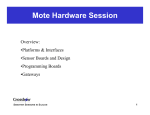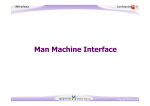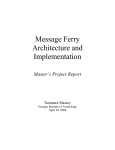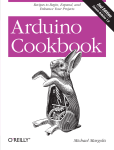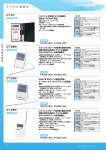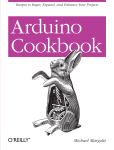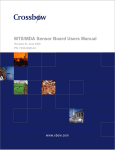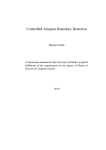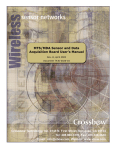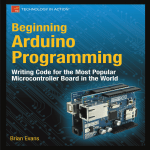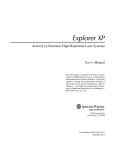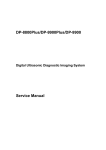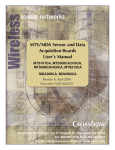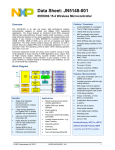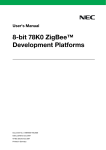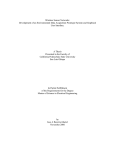Download Intro to Motes
Transcript
Introduction to Motes Portions adapted from: Crossbow, Inc. Bill Maurer [email protected] DSP Labs, Livermore Ca., USA www.intel-research.net/berkeley/ 1 Why Smart Dust ? • Advances in low power wireless communication technology and microelectromechanical sensors (MEMS) transducers • “Digital Nervous System” • “Physical Internet” • “Ubiquitous Computing” 2 1 NEST Technology • How do you combine sensing, communication and computation into a complete architecture ? • What are the requirements of the software? • Networked-Embedded-SystemsTechnology 3 Ad hoc sensing • Autonomous nodes self assembling into a network of sensors • Sensor information propagated to central collection point • Intermediate nodes assist distant nodes to reach the base station 4 2 Today’s Hardware • Assembled from off-the-shelf components • 8bit MCU • Low-Power Radio • Sensors • I/O 5 Key Software Requirements • Capable of fine grained concurrency • Small physical size • Efficient resource utilization • Highly modular 6 3 What is TinyOS ? • An Open-Source Development Environment • A Simple Operating System • A Programming Language and Model • A Set of Services 7 TinyOS – Development Environment • Windows and Linux • Multiple Hardware Platforms – Not only Crossbow • Multiple Sensors – Not only Crossbow • Debugging Tools • Reference Applications 8 4 TinyOS – A Simple Operating System • Scheduler • Concurrency Intensive • Limited Resources – SW Components for Efficient Modularity 9 TinyOS – A Programming Language and Model • Separation of construction and composition: – programs are built out of components • Specification of component behavior in terms of set of interfaces • Components are statically wired to each other via their interfaces. – This increases runtime efficiency 10 5 TinyOS - Services • • • • • • Radio, MAC, Messaging, Routing Sensor Interfaces Power Management Security Debug Time 11 Why TinyOS ? • Unix Analog (aka 1969) – A Uniform Programming Language • C – A Uniform Abstraction • E.g, device abstraction – Open Source • Many Different Developers • Many Different Needs – Many Tools 12 6 Who Controls TinyOS ? • UC Berkeley Invented – 1st written by Jason Hill in 2000 – Large portion of development changed to Intel-Berkeley Research Lab • Intel-Berkeley Research Lab has largest role today in core ‘OS’ components – www.intel-research.net/berkeley/ 13 Real-World Deployments Great Duck Island http://www.greatduckisland.net/ Center for Embedded Network Sensing http://www.cens.ucla.edu/ 14 7 Introduction to TinyOS and nesC Programming • • • • TinyOS Kernel Design and Implementation nesC Software Concepts and Basic Syntax nesC Code Lab TinyOS Packet Networking and PC Base Station Lab 15 TinyOS Design Goals • Support Networked Embedded Systems – asleep but remain vigilant to stimuli – bursts of events and operations • Support Mica Hardware – power, sensing, computation, communication • Support Technological Advances – keep scaling down – smaller, cheaper, lower power 16 8 TinyOS Design Options • Can’t Use Existing RTOS’s – Microkernel Architecture • VxWorks, QNX, WinCE, PalmOS – Execution Similar to Desktop Systems • PDA’s, Cell Phones, Embedded PC’s – More Than a Order of Magnitude Too Heavy & Slow – Energy Hog 17 TinyOS Design Conclusion • Similar to Building Networking Interfaces – Data Driven Execution – Manage Large # of Concurrent Data Flows – Manage Large # of Outstanding Events • Add: Managing Application Data Processing • Conclusion: Need a Multi Threading Engine – Extremely Efficient – Extremely Simple 18 9 TinyOS Kernel Design • TinyOS Kernel: 2 Level Scheduling Structure – Events • Small Amount of Processing • E.g. Timer, ADC Interrupts • Can Interrupt Longer Running Tasks – Tasks • • • • Not Time Critical Tasks - Larger Amount of Processing E.g. Computing an Average on an Array Run to Completion WRT other Tasks – Implies Only Need a Single Stack 19 TinyOS Applications Under The Hood • Application is created in the nesC Language – Details of nesC Forthcoming • nesC Programming Language Supports the TinyOS Kernel Design (Events and Tasks) TinyOS Kernel (C) TinyOS Libs (nesC) Application (nesC) nesC Compiler Application & TinyOS (C) C Compiler 20 Application Executable 10 The TinyOS Kernel Under The Hood (nesC Compiler C Code Output) int main(void) { RealMain$hardwareInit(); TOSH_sched_init(); Hardware and Kernel Initialization bool TOSH_run_next_task(void) { uint8_t old_full; void (*func)(void ); if (TOSH_sched_full == TOSH_sched_free) { return 0; } else { old_full = TOSH_sched_full; TOSH_sched_full++; TOSH_sched_full &= TOSH_TASK_BITMASK; func = TOSH_queue[(int )old_full].tp; TOSH_queue[(int )old_full].tp = 0; func(); return 1; } } Application Initialization RealMain$StdControl$init(); RealMain$StdControl$start(); RealMain$Interrupt$enable(); while (1) { TOSH_run_task(); } Infinite Loop 1. First Run All Tasks in the Task Queue (Strictly a FIFO) } static inline void TOSH_run_task(void) { while (TOSH_run_next_task()) ; TOSH_sleep(); TOSH_wait(); } Task Runs To Completion (But May Be Interrupted By An Event) 2. Then Sleep (In Low Power Mode) 3. And Wait for an Interrupt 21 Overhead of TinyOS Primitive Operations Operation Byte Copy Signal an Event Call a Command Schedule a Task Context Switch Cost(cycles) Time(uSecs) 8 Normalized to Byte Copy 2 1 10 10 46 51 2.5 2.5 11.5 12.75 1.25 1.25 6 6 Hardware Interrupt (hw) 9 Hardware Interrupt (sw) 71 2.25 17.75 1 9 Code and Data Size of the TinyOS kernel Processor Init Scheduler C runtime Code Size(bytes) Data Size(bytes) 172 178 82 30 16 0 432 46 22 11 TinyOS/nesC Application Notes • Everything is Static – No Dynamic Memory (no malloc) – No Function Pointers – No Heap • nesC Compiler Analysis – – – – Data Race Conditions Function Inlining Development Made Easier Robustness Improved 23 Application Memory Map • Text/code - Executable Code – In the 128K Program Flash • data – Program Constants – In the 128K Program Flash • bss - Variables – In the 4K SRAM • Free Space - Fixed (No Dynamic Memory) • stack - Grows Down in the Free Space 24 12 TinyOS Concepts Embodied by nesC – Tasks, Events, Commands • Tasks – Background computation, non-time critical • Events – – – – Time critical External Interrupts Originator gives a ‘Signal’ Receiver gets/accepts an ‘Event’ • Command signal Component task event command – Function call to another Component – Cannot Signal 25 Concepts of SW Components Main.nc • Interfaces (xxx.nc) • Specifies functionality to outside world • Tell outside world appxxx.nc (No code Wiring only) – what commands can be called – what events need handling • Software Components interfaceA.nc – Module (xxxM.nc) • Code file, code implementation • It codes the Interface – Configuration (xxxC.nc) interfaceA.nc interfaceA.nc comp1C.nc comp2M.nc (code) • Linking/wiring of components (wires) • When top level app, drop C from filename interfaceB.nc xxx.nc • optional Module TinyOS app Blink – Blinks the Red LED BlinkM.nc Blink.nc interfaceB.nc comp3M.nc (code) 26 Ad infinitum... 13 Blink.nc Application - A top level configuration SW component used to form an executable tos/system/Main.nc What the executable does: 1. Main initializes and starts the application. 2.BlinkM initializes ClockC’s rate at 1Hz. 3. ClockC continuously signals BlinkM at a rate of 1 Hz. 4. BlinkM commands LedsC red led to toggle each time it receives a signal from ClockC. Note: The StdControl interface is similar to state machines (init, start, stop); used extensively throughout TinyOS apps & libs tos/interfaces/StdControl.nc Blink.nc tos/interfaces/StdControl.nc BlinkM.nc Blink.nc tos/interfaces/Clock.nc tos/interfaces/Clock.nc tos/system/ClockC.nc tos/interfaces/Leds.nc tos/interfaces/Leds.nc tos/system/LedsC.nc 27 Mote Hardware 28 14 Family of Motes 29 Mica2 and Mica2Dot • ATmega128 CPU 1 inch – Self-programming • Chipcon CC1000 – FSK – Manchester encoding – Tunable frequency • Lower power consumption 30 15 Common Platform Architecture • Atmega uP • 32Khz crystal and 4Mhz (7.3728Mhz Mica2) crystal. • 10 bit ADC LEDS • UART (Mica2/Mica2Dot have 2) • Radio (RFM or Chipcon 1000) Atmega uP SERIAL FLASH • I2C bus (hardware for mica2/mica2dot) 51 PIN I/O CONNECTOR • SPI bus • External serial flash memory (512K byte) • Connectors for interfacing to sensor and programming boards RADIO • 3 programmable leds (1 for Mica2Dot) • JTAG port (Mica, Mica2, Mica2Dot) 31 The CC1000 Radio Interface • Dedicated cpu bus (lines) to configure radio registers for radio frequency, power,….. • Dedicated SPI bus for data transfer. CC1000 is bus master. • Radio generates one interrupt every 8 bits when in receive mode. • Runs usually at 38K or 19K bit rate (default) Manchester (2x bit) • More in-depth radio discussion later in session. Baud Rate Xmt or Rcv Time(*) 19K ~40msec 38K ~20msec (*) Does not include random delay 32 16 The Flash Memory Interface • 512 K bytes of flash (non-volatile) storage • Useful for data logging. • Used by GSK (Generic Sensor Kit) and TinyDB for data logging. • Used by XNP for code download. • Serial interface to Atmega uP • TinyOS driver (Logger..) bit bangs interface • Attached to 2nd uart port on Mica2. Another driver (UCB) uses synchonous usart for high speed data transfer.(5KB/Sec driver) •Beware, device consumes 15 ma when storing to memory 33 The ADC Interface • Eight channels of 10 bit ADC, multiplexed. • Dedicated channels (Mica2): • ADC0 : Radio’s RSSI • Shared Mica2 Channels • ADC7 : Battery monitor (can be shared with another channel but will have ~10K ohm impedance. • ADC4..ADC7: JTAG. If using JTAG debug these channels won’t work as ADC inputs. • Shared Mica2Dot Channels • ADC1: Shared for both thermistor and battery voltage • ADC4..ADC7: JTAG. If using JTAG debug these channels won’t work as ADC inputs 34 17 Mica2 Sensor Interface Pin 1 2 3 4 5 6 7 Name GND VSNR INT3 INT2 INT1 INT0 BAT_MON 8 9 10 11 12 13 14 15 16 17 18 19 20 21 22 23 24 25 26 LED3 LED2 LED1 RD WR ALE PW7 USART1_CLK PROG_MOSI PROG_MISO SPI_CLK USART1_RXD USART1_TXD I2C_CLK I2C_DATA PWMO PWM1A AC+ AC- Description Ground Voltage(battery) GPIO GPIO GPIO GPIO Battery Monitor Voltage Green Led Yellow Led Red Led GPIO GPIO GPIO GPIO Usart clock Programmer Pin Programmer Pin Radio Clock Usart1 receive Usart1 xmit I2C bus clock I2C bus data GPIO GPIO GPIO GPIO Pin 27 28 29 30 31 32 33 Name UART_RXDO UART_TXDO PWO PW1 PW2 PW3 PW4 Description Uart0 Rcv Uart0 Tx GPIO/PWM GPIO/PWM GPIO/PWM GPIO/PWM GPIO/PWM 34 35 36 37 38 39 40 41 42 43 44 45 46 47 48 49 50 51 PW5 PW6 ADC7 ADC6 ADC5 ADC4 ADC3 ADC2 ADC1 ADC0 THERM_PWR THRU1 THRU2 THRU3 RSTN PWM1B VCC GND GPIO/PWM GPIO/PWM GPIO/ADC CH7, JTAG GPIO/ADC CH6, JTAG GPIO/ADC CH5, JTAG GPIO/ADC CH, JTAG GPIO/ADC CH3 GPIO/ADC CH2 GPIO/ADC CH1 GPIO/ADC CH0 GPIO Thru user connect Thru user connect Thru user connect uP reset GPIO Voltage (battery) ground Blue: OK to use Yellow: OK to use but has shared functionality Red: Do no use See Atmega128 specification for more information regarding signal functionality. 35 Mica2 Sensor Interface 36 18 Mica2Dot Sensor Interface P IN TP1 TP2 TP3 TP4 TP5 TP6 TP7 TP8 TP9 T P10 T P11 T P12 T P13 T P14 T P15 T P18 T P19 T P20 T P21 D E S C R IP T IO N GND ADC7 ADC6 ADC5 ADC4 VCC PW 1 PW 0 U A R T _T X D U A R T _R X D R ESETN S P I_ C K ADC3 ADC2 PW M 1B GND IN T 1 IN T 0 T H ER M _PW R • 6 ADC Channels • 6 I/O Channels 37 Power Budgets SYSTEM SPECIFICATIONS Currents value Micro Processor (Atmega128L) current (full operation) current sleep Radio (Chipconn 1000) current in receive current xmit current sleep Flash Serial Memory (AT45DB041) write read sleep Sensor Board current (full operation) units 6 ma 8 ua 8 ma 12 ma 2 ua 15 ma 4 ma 2 ua 5 ma Average, full operation, current: ~15 ma AA Batteries are ~1800ma which mean ~ 120hrs (5 days) 38 19 Batteries • AA – standard, 1800ma hours. Slow decay. Best price. •Lithium – 3.6, fast decay, more expensive. •Beware of low battery voltage (adc, flash programming…..) •DC Booster may/may not help •UCB Mica2Dot NiMH 3AH, single cell, with booster and recharge. 39 Crossbow Sensor Boards Part # Mote Support Sensors MTS101CA MICA,MICA2 Light (photo resistor) Temperature (Thermistor) Prototyping area MDA300CA MICA2DOT Protoyping MTS300CA MICA, MICA2 Light, Temperature, Acoustic, Sounder, 2-Axis Accelerometer (ADXL202), and 2-Axis Magnetometer MTS500CA Mica2Dot Prototyping MDA300CA Mica2 On board humidity/temp. External sensors. MTS400/420 Mica2 GPS weatherboard Not released: Weatherboards Mica2Dot See MTS/MDA Sensor and Data Acquisition Boards User’s Manual 40 20 MTS101CA •Light photo resistor-Clairex CL94L • Thermistor - YSI 44006, •Both sensor are highly non-linear. •Good prototyping area. To use this sensor board add (modify) the apps/app/makefile for: SENSORBOARD = basicsb PW2 PW1 RT1 Thermistor R2 Photoresistor ADC5 a b c d e U 1 1 2 6 1 2 3 4 5 6 7 8 9 10 11 12 2 7 5 1 R3 10K, 5% T h e r m is t o r ( R T 1 ) gnd_analog ADC6 R1 10K, 5% gnd_analog L ig h t S e n s o r ( R 2 ) 41 a b c d e MDA500CA • Prototyping board for mica2dots 42 21 MTS300CA/MTS310CA • • • • • • • Light (Photo)-Clairex CL94L Temperature-Panasonic ERT-J1VR103J Acceleration-ADI ADXL202 – 2 axis – Resolution: ±2mg Magnetometer-Honeywell HMC1002 – Resolution: 134µG Microphone Tone Detector Sounder – 4.5kHz SENSORBOARD = micasb 43 MTS400/420 – GPS/Weather • Gps (LeadTek 9546) - optional • SiRFstartII LP chipset (60ma) • External active antenna. • 12 channels • 15 Meter ( SA off); 7 Meter (WAAS corrected) • DC Booster to maintain required voltage •Temperature & Humidity (Sensirion SHT11). • All digital (14 bits) • 3.5% RH accuracy, 0.5degC Temperature accuracy 44 22 MTS400/420 – GPS/Weather •Barometric Pressure and Temperature (Intersema MS5534A) • All digital • 300 to1100 mbar, 3% accuracy • -10 to +60 degC, 3% accuracy • Ambient Light (TAOS TSL2250) •All digital •400-1000nm response •Acceleration-ADI ADXL202 –2 axis –Resolution: ±2mg •2 K EEPROM for user configuration info. 45 MDA300 • • • • • • • 8 External Analog Inputs – External Sensors – Hi and low level signals – Block Screw Terminal 8 channel digital I/O 2 relays On board 12-bit ADC – 0-2.5V, 0-3V, 0-5V Ranges Stable 2.5V Reference 3V and 5V power Designed by UCLA CENS w/ Crossbow and UCB http://www.cens.ucla.edu/~mhr/daq/46 23 PNI- Magnetometer/Compass • Resolution: 400 µGauss • Very low power • Three axis 47 Ultrasonic Transceiver • Used for ranging • Up to 2.5m range • 6cm accuracy • Dedicated microprocessor • 25kHz element • Mica2 and Mica2Dot 48 versions 24 Mica2Dot WB • UCB environmentally packaged weatherboards for GDI •Temperature & Humidity (Sensirion SHT11). • All digital (14 bits) • 3.5% RH accuracy, 0.5degC Temperature accuracy •Barometric Pressure and Temperature (Intersema MS5534A) • All digital • 300 to1100 mbar, 3% accuracy • -10 to +60 degC, 3% accuracy •Ambient Light (TAOS TSL2250) •All digital •400-1000nm response • Photosensitive Light Sensor.. 49 Mote In Tires • Real time control of vehicle dynamics. •3 bridge accelerometers (500g-1000g) mounted in tire. • Sensor board has 3 channels of amplifiers, filters, programmable D/As for bridge balancing. •Monitor and analyzed acceleration forces when tire is in contact with ground. • Transmit results every revolution. • 3 motes, 1 master, 2 slaves. 50 25 Micro Radar •Darpa project: Detect intruders with micro-powered radar detectors and relay data through mote network. •Drop detectors from UAV (ex: Predator) •Ghz Doppler radar detector. • Done with LLL and Advantaca 51 COTS-BOTS (UCB) • 5” x 2.5” x 3” size • <$250 total • 2-axis accelerometer 52 26 Robomote (USC) • Less than 0.000047m3 • $150 each • Platform to test algorithms for adaptive wireless networks with autonomous robots 53 MICAbot (Notre Dame) • • Designed for large-scale research in distributed robotics and ad-hoc wireless networking. $300 each 54 27 Ratiometric Adcs & Sensors • Atmega128 is 10 bit (1024) ratio metric ADC • If sensor is ratio metric then don’t have to measure battery voltage. (Sensor’s FS changes with battery voltage). •Ratio metric sensors may not work over full range of battery voltage. •ADC full scale is proportional to battery voltage. • Must measure battery voltage to get accurate sensor readings: ADC Output vs Battery Voltage for 1.5V input 700 680 660 640 620 600 580 560 540 520 500 2 2.5 3 3.5 Battery Volts = RefVolt*ADC_FS/data •Mica2 and Mica2Dot have on-board voltage references to calibrate the ADC full scale. /contrib/xbow/apps/XSensorMica2 55 Enclosures for Environmental Monitoring 56 28 Mica2Dot Enclosures Weather Sensors On/Off O-Ring Battery Interface Board Battery 57 Sensor Power Management • Simple Strategy for Low Power Sensors: PW2 • Use Atmega output pins to source sensor power. RT1 Thermistor • Will source ~5-10ma of current per pin. R3 10K, 5% ADC5 • Analog Switch Strategy gnd_analog • Use hardware I2C (mica2) or software I2C (mica2dot) (in Sourceforge) VCC • Switch connects sensor power to VCC. I2C_BUS_1_DATA I2C_BUS_1_CLK • Create +5 V or more I2C_BUS_1_DATA I2C_BUS_1_CLK VCC S8 S7 S6 S5 S4 S3 S2 S1 ADG715BRU 19 D8 17 D7 15 D6 13 D5 12 D4 10 D3 8 D2 6 D1 3 1 SDA SCLK 23 24 RST 22 A0 A1 5V_DC-DC_Shutdown 3.3V_DC-DC_Shutdown Accel_Power EEPROM_Power Humidity_Power Pressure_Power Light_Power R11 R9 1M 1M R10 R13 R12 1M 1M 1M VSS GND • DC-DC Booster Strategy U7 21 4 Accel_Out 20 18 16 14 11 9 7 5 2 R19 R17 1M 1M • ADG714 switch has 2.5 ohm on resistance • Create battery independent, constant supply voltage. Power Switches • Turn on booster from analog switch or Atmega • Boosters are ~80%-90% efficient. Need good layout and decoupling. Not ratiometric 58 29 Mote Programming and Base Station Boards Overview: • MIB500 Parallel Port Programmer • MIB510 Serial Port Programmer • eMote • USB 59 MIB500 •Programs mote through the PC’s parallel port •Supports Mica, Mica2, Mica2Dot •Voltage monitor to protect from low battery voltage. Low battery voltage can cause fuse errors. •Serial port for base station operation •Parallel port can cause flash corruption on some computers due to uisp parallel port drivers. THESE MAY BE IRRECOVERABLE • Crossbow application note at www.xbow.com to help fix uisp problems. • JTAG connector: AVRStudio and JTAG pod allows viewing and setting all fuses. 60 30 MIB510 • Q3 release •Programming through the serial port. On board ISP uP is 3x faster than parallel port. •Shares serial port with mote for base station operation. •Voltage monitor to protect from low battery voltage • Suports Mica (Atmega128 uP only), Mica2, Mica2Dot • JTAG port powered directly. 61 USB • Q4 release •USB interface for programming and base station operation . •Power supplied thru USB. 62 31 eMote Ethernet connection as serial forwarder. •Programming through ethernet. ISP uP Serial • Remote powered ethernet sensor. • Remote code debugging through ethernet. Ideal for mote network debug. Ethernet • Remote base station operation through ethernet. Serial MOTE SENSOR BOARD • Similar configuration (eprb) used extensively at UCB for mote development. 63 32
































